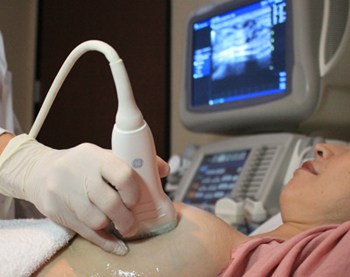Breast Ultrasound
What is breast ultrasound?
Breast ultrasound uses sound waves to make images of the breast. Ultrasound images may be called sonograms.

Image courtesy of Lange Productions.
Breast ultrasound is non-invasive. It’s often used as a follow-up test after an abnormal finding on a screening mammogram, breast MRI or clinical breast exam.
If a needle biopsy is needed, breast ultrasound may be used to help guide the procedure.
Learn more about follow-up after an abnormal finding.
Learn more about breast cancer diagnosis.
The following is an interactive model of what a breast ultrasound may show.
Breast cancer screening
Whole breast ultrasound is an ultrasound of the entire breast. Studies show whole breast ultrasound alone is not a good breast cancer screening tool [88,91].
Whole breast ultrasound has many false positive and false negative results [88,91]. A false positive result shows a person has breast cancer when they do not. A false negative result shows a person doesn’t have breast cancer when in fact, they do have breast cancer.
Whole breast ultrasound is not part of the National Comprehensive Cancer Network (NCCN) or the American Cancer Society (ACS) breast cancer screening recommendations [8-9].
However, targeted breast ultrasound (of the suspicious area only) is often used as a follow-up test after an abnormal finding on a screening mammogram, breast MRI or clinical breast exam.
Learn about breast cancer screening recommendations for women at average risk.
Learn about breast cancer screening recommendations for women at higher risk.
Learn about breast cancer screening recommendations for transgender people.
Under study
Whole breast ultrasound alone is not a good breast cancer screening tool. More research is needed to see if it’s helpful when used in combination with mammography or breast MRI [92-93].
Whole breast ultrasound and dense breast tissue
Studies have shown mammography combined with whole breast ultrasound may find a few more breast cancers than mammography alone in women with dense breasts [21,88-89,93-98].
However, mammography plus whole breast ultrasound leads to more false positive results than mammography alone [21,88-89,93-98]. False positive results must be checked to be sure there’s no breast cancer. Follow-up tests, and sometimes a breast biopsy, are needed to check a false positive result.
There are no special screening guidelines for women with dense breasts [8-9]. Whole breast ultrasound is not part of the NCCN or the ACS breast cancer screening recommendations for women at average risk or for women at higher risk [8-9].
Learn more about breast cancer screening recommendations.
Learn more about breast density and mammography.
Learn more about breast density and breast cancer risk.
Whole breast ultrasound for women at higher risk of breast cancer
For women at higher risk of breast cancer, screening with whole breast ultrasound doesn’t appear to add extra benefit to screening with breast MRI and mammography [88,98].
Studies are looking at whether whole breast ultrasound may be a useful addition to screening mammography among women at higher risk of breast cancer for whom breast MRI is not recommended [88].
Women at higher risk who are recommended to have breast MRI as part of breast cancer screening, but can’t have one for medical reasons, may consider whole breast ultrasound [9].
Learn about breast cancer screening recommendations for women at higher risk.
Automated whole breast ultrasound
Whole breast ultrasound exams are most often performed with a hand-held ultrasound device (see image above). The quality of the image can vary greatly, depending on the skill and experience of the person doing the exam.
Automated whole breast ultrasound is under study to see if it may help improve image quality [95]. However, it’s not widely available or routinely used.
Updated 11/29/22

